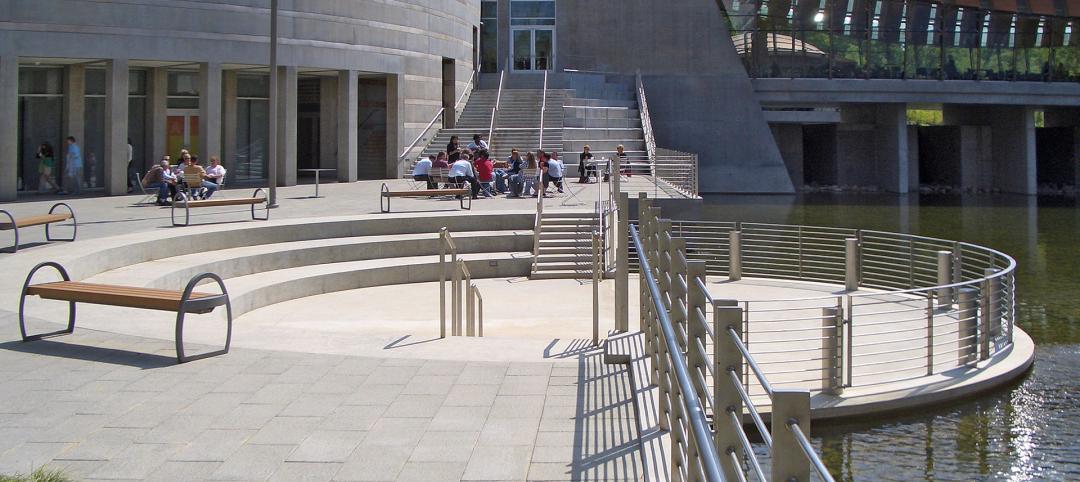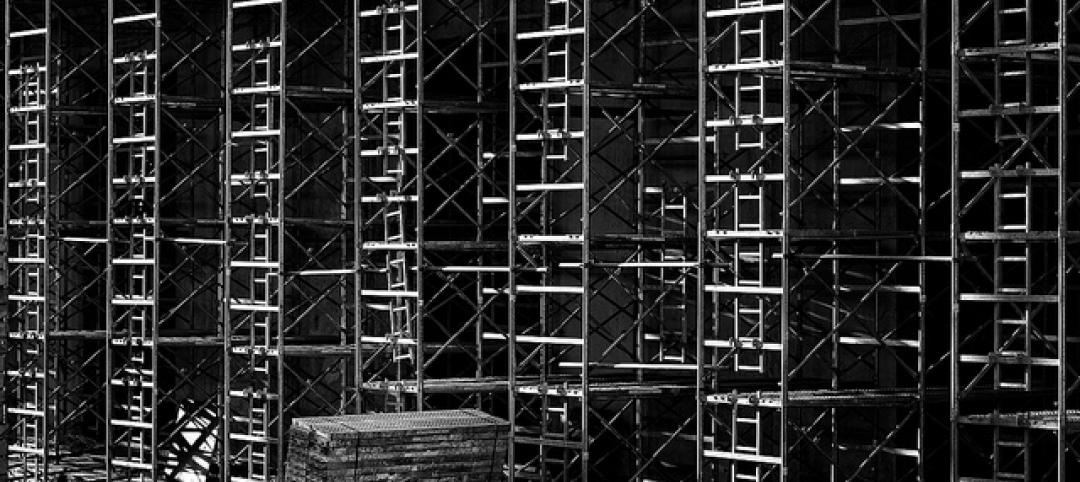The University of Notre Dame announced this morning the largest building project in its 172-year history, integrating the academy, student life, and athletics with the construction of more than 750,000 sf in three new buildings attached to the west, east, and south sides of the school's iconic football stadium, at a projected cost of $400 million.
The plan, called the Campus Crossroads Project, features new structures attached to and serving the stadium: a west building for student life services, including space for student organizations, a recreation center and career center; an east building for the anthropology and psychology departments and a digital media center; and a south building for the Department of Music and the Sacred Music at Notre Dame program. The east and west buildings also will include some 3,000 to 4,000 premium seats for the football stadium with supporting club amenities.
The lead architectural firm for the Crossroads Project is The S/L/A/M Collaborative. RATIO Architects is the co-designer. Other consultants include Workshop Architects for the student center and 360 Architecture for the recreation, fitness, and hospitality areas. The contractor is Barton Malow Co.
Central components to the plan include the addition of meeting, research, and teaching venues, as well as facilities that do not currently exist on campus, such as a 500-person ballroom. The various new spaces also will be designed to accommodate multiple functions for multiple departments, such as the stadium club spaces, which also will be used for student services, academic event space, classrooms, conferences, career fairs, and other campus and community activities.
The exterior design of the Campus Crossroads Project is inspired by Knute Rockne’s original Notre Dame Stadium—which still stands today as the core of the facility—and is wed with materials, massing, and details taken from many of the Collegiate Gothic buildings on the campus.
The area between the stadium and the DeBartolo Hall classroom building will become a pedestrian plaza with walkways, trees, planters, and seating areas. The entire project will include sustainability practices consistent with other University projects.
The project also will enhance the football fan experience on game days. A variety of premium seating options—both indoor and outdoor and mostly club seats—will be available on three upper levels on the east and west sides. A hospitality area also is planned for the new building on the south end of the stadium.
Football fans, especially younger ones, have expressed a clear desire to have better access to data and video when attending Notre Dame games. Some of that will be addressed through enhanced broadband connectivity and some by the introduction of video, though the shape that will take has not yet been finalized. However, to the extent the University provides video, whether in the concourse or in the stadium itself—similar to the philosophy in Purcell Pavilion and the Compton Family Ice Arena—there will be no commercial signage or advertising.
Notre Dame Stadium opened in 1930 and was expanded to its current configuration in 1997. One of the nation’s most iconic athletics venues, it is used for home football games, the University Commencement Ceremony and several other events.
Features of the three new buildings include:
West building
Space designed to enhance student development and formation will dominate the nine-story west building. Planning has ensured that the new facility will complement the student organization space and administrative offices located in the historic LaFortune Student Center.
Levels 1 and 2: Flexible, state-of-the-art meeting rooms, graduate and undergraduate student lounges, a dining area, student organization space and administrative offices.
Levels 3 and 4: Recreational sports and fitness facilities (the Rolfs Sports Recreation Center will become the practice home for the men’s and women’s varsity basketball teams).
Level 5: A career services center, centralized and expanded with more than 40 interview rooms, multiple training rooms and conference areas, an employer lounge and advising offices. The existing working press space on this level will be integrated into a premium seating area for the stadium.
Level 6: Mechanical support.
Level 7: A 500-seat student ballroom, club seating for football and booths for NBCSports telecasts of home football games. Student-oriented programming will have priority booking for non-game weekends.
Level 8: Premium stadium seats and terraces that will look onto the campus and the playing field.
Level 9: Club seating, boxes for home and visiting coaches, security booths and boxes for administrative and athletic department leaders.
Basement: Food service space for the three new buildings and the stadium.
South building
The relocation of the Department of Music and Sacred Music Program will provide much needed new and state-of-the-art space for these growing programs. It also will put music into close proximity to other performing arts departments and programs.
Level 1: Recital and rehearsal halls and the Leahy gate grand entrance to the stadium.
Level 2: A large music library, to be relocated from the Hesburgh Library, classrooms and rehearsal and tutoring rooms.
Level 3: A 350-person club/lounge.
Level 4: Department of Music offices, practice rooms and storage.
Level 5: The Sacred Music Program, offices, organ practice rooms and storage.
Level 6: Mechanical, with a scoreboard on the exterior.
East building
Offices and laboratories for the Departments of Anthropology andPsychology, which are housed in a variety of buildings on campus, now will be in one place and located closer to other social sciences departments, the College of Scienceand international institutes.
Level 1: A digital media center with a 2,000-square-foot studio and production, teaching, learning, research and scholarship facilities for use by faculty, students, University Communications, athletics and information technology will position Notre Dame as a national leader in what is a rapidly expanding and increasingly important component of higher education. A control room will support faith-based programming, such as Masses at the Basilica of the Sacred Heart, as well as athletics events, performing arts presentations and academic lectures and speeches.
Level 2: Anthropology offices, administrative space, conference and tutoring areas and multifunction research and teaching labs.
Levels 3, 4 and 5: Psychology offices, classrooms, labs, computer rooms and a student lounge.
Level 6: Mechanical support.
Level 7: Outdoor club seating for football, outdoor terraces and a large space that will double as a club area and flexible classroom.
Level 8: Outdoor club seating for football.
Level 9: Working press box, radio booths and a club area with indoor and outdoor premium seating for football.
For more on the Campus Crossroads Project, visit: http://crossroads.nd.edu.
Related Stories
| Dec 11, 2014
Moshe Safdie awarded 2015 AIA Gold Medal
The AIA Gold Medal, voted on annually, honors an individual whose significant body of work has had a lasting influence on the theory and practice of architecture.
| Dec 10, 2014
International Olympic Committee releases first images of new HQ in Switzerland
Designed by 3XN, the new headquarters is located within a park on the shores of Lake Geneva and adjacent to historic Château de Vidy, which has been the iconic home of the IOC.
| Dec 10, 2014
CannonDesign acquires Astorino, forms design-led design-build division
The merger also extends CannonDesign’s presence in the markets Astorino currently serves, namely Pittsburgh and Abu Dhabi.
| Dec 10, 2014
Must see: Babina's latest illustrations cast famous architecture quotes as colorful road signs
Babina has adapted quotes from famous names such as Frank Lloyd Wright, Alvar Aalto, and Mies Van Der Rohe.
| Dec 9, 2014
Steven Holl wins Mumbai City Museum competition with 'solar water' scheme
Steven Holl's design for the new wing features a reflective pool that will generate energy.
| Dec 9, 2014
ABC economist predicts continued construction industry growth in 2015
In his latest report, ABC's Chief Economist Anirban Basu forecasts nonresidential construction spending to expand by roughly 7.5% next year, led by the power, lodging, office, and manufacturing sectors.
| Dec 8, 2014
How brick and mortar enables online retail
According to a shopping preferences study conducted by A.T. Kearney, as many as two-thirds of shoppers go to a physical store before or after making an online purchase, writes Gensler's Jill Nickels.
| Dec 8, 2014
The year’s boldest BIM/VDC themes
High-speed rendering software, custom APIs, virtual reality tools, and BIM workflow tips were among the hottest BIM/VDC topics in 2014.
| Dec 8, 2014
AEC firms upbeat about financial results, 2015 looking rosier [exclusive BD+C survey]
The market outlook is brighter for U.S. architecture, engineering, and construction companies, with a majority of AEC firms reporting higher revenues, strong forecasts, and sound financial health, according to BD+C's annual Market Forecast Survey.
| Dec 8, 2014
The global sanitation crisis leads to 2.5 million deaths every year
When we see the incredible technology being produced by global plumbing manufacturers, it’s hard to conceive why no viable technical solution to the global sanitation issue has come forth, writes BD+C's Robert Cassidy.

























